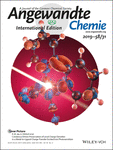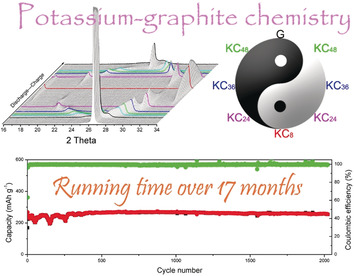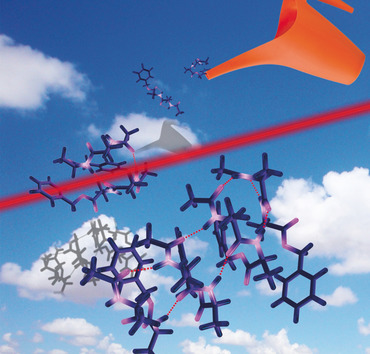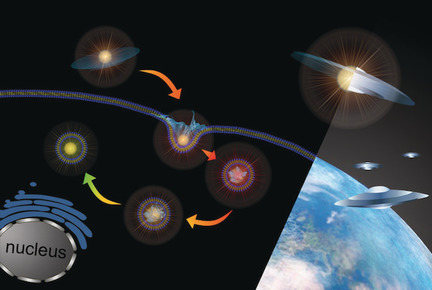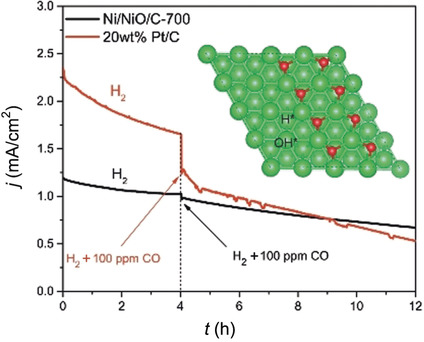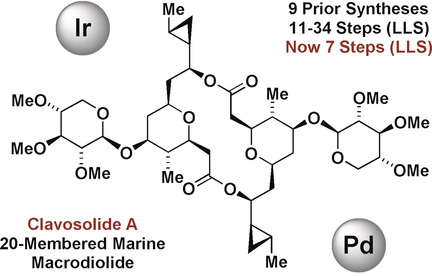Journal list menu
Export Citations
Download PDFs
Cover Pictures
Cover Picture: Covalency-Driven Preservation of Local Charge Densities in a Metal-to-Ligand Charge-Transfer Excited Iron Photosensitizer (Angew. Chem. Int. Ed. 31/2019)
- Page: 10377
- First Published: 17 July 2019
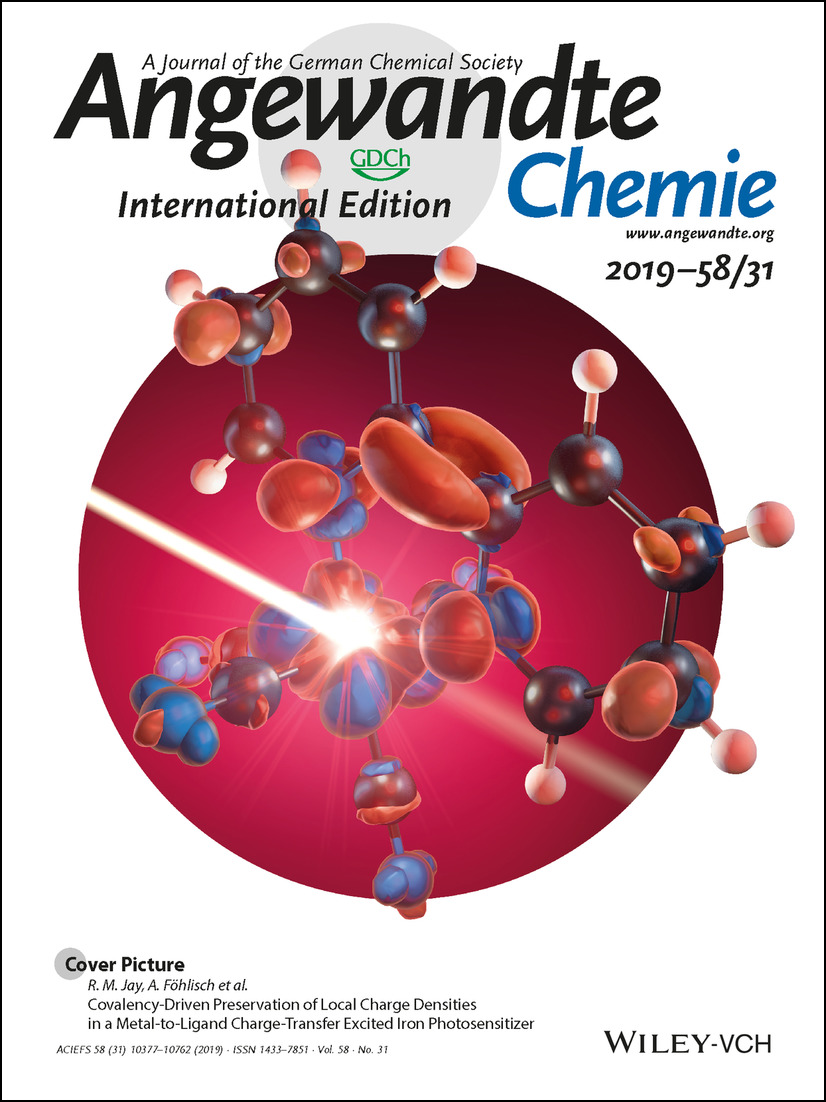
Charge-density rearrangements after metal-to-ligand charge-transfer excitation in an iron photosensitizer are investigated by R. M. Jay, A. Föhlisch et al. in their Communication on page 10742 ff. Using time-resolved X-ray absorption spectroscopy, surprising covalency effects are revealed that inhibit charge separation at the intramolecular level. Furthermore, the underlying mechanism is proposed to be in effect for all commonly used photosensitizers in light-harvesting applications, which challenges the common perception of electronic charge transfer.
Inside Cover: Stereoselective Synthesis of Highly Substituted Conjugated Dienes via Pd-Catalyzed Carbonylation of 1,3-Diynes (Angew. Chem. Int. Ed. 31/2019)
- Page: 10378
- First Published: 09 July 2019
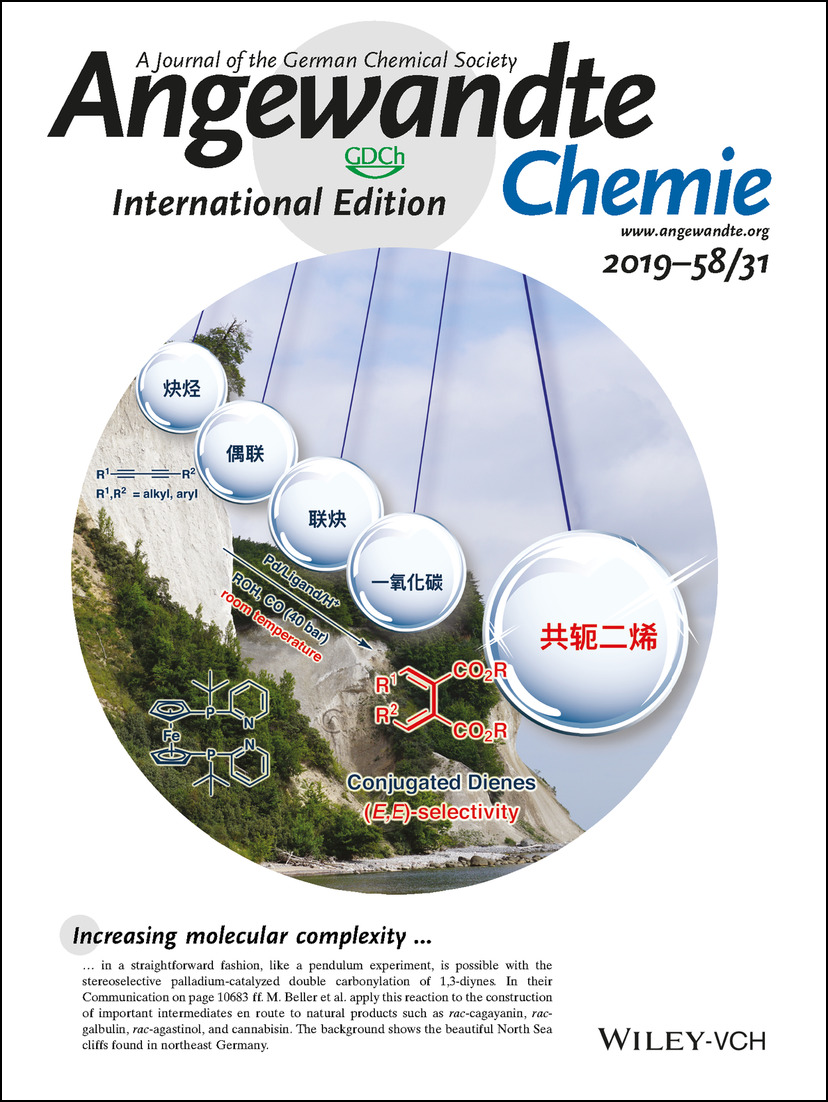
Increasing molecular complexity in a straightforward fashion, like a pendulum experiment, is possible with the stereoselective palladium-catalyzed double carbonylation of 1,3-diynes. In their Communication on page 10683 ff. M. Beller et al. apply this reaction to the construction of important intermediates en route to natural products such as rac-cagayanin, rac-galbulin, rac-agastinol, and cannabisin. The background shows the beautiful North Sea cliffs found in northeast Germany.
Inside Back Cover: The Miharamycins and Amipurimycin: their Structural Revision and the Total Synthesis of the Latter (Angew. Chem. Int. Ed. 31/2019)
- Page: 10761
- First Published: 05 July 2019
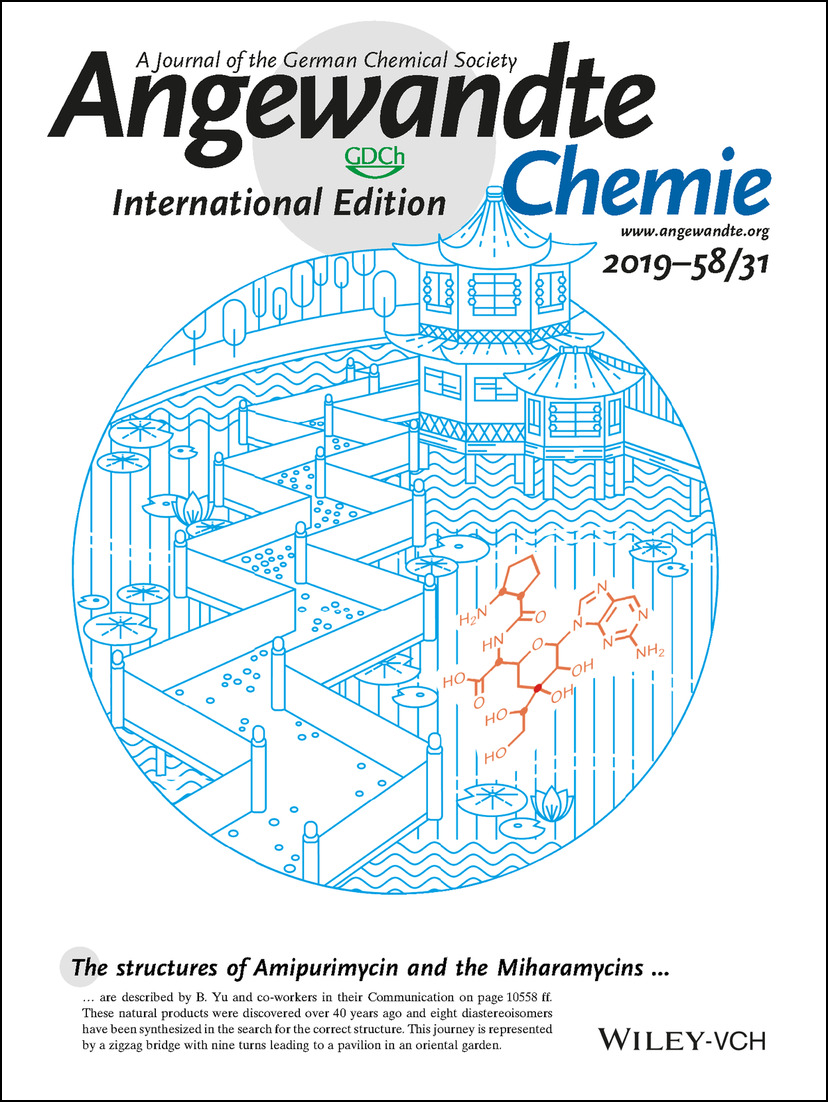
The structures of Amipurimycin and the Miharamycins are described by B. Yu and co-workers in their Communication on page 10558 ff. These natural products were discovered over 40 years ago and eight diastereoisomers have been synthesized in the search for the correct structure. This journey is represented by a zigzag bridge with nine turns leading to a pavilion in an oriental garden.
Back Cover: Transition-Metal-Free Hydrogen Autotransfer: Diastereoselective N-Alkylation of Amines with Racemic Alcohols (Angew. Chem. Int. Ed. 31/2019)
- Page: 10762
- First Published: 10 July 2019
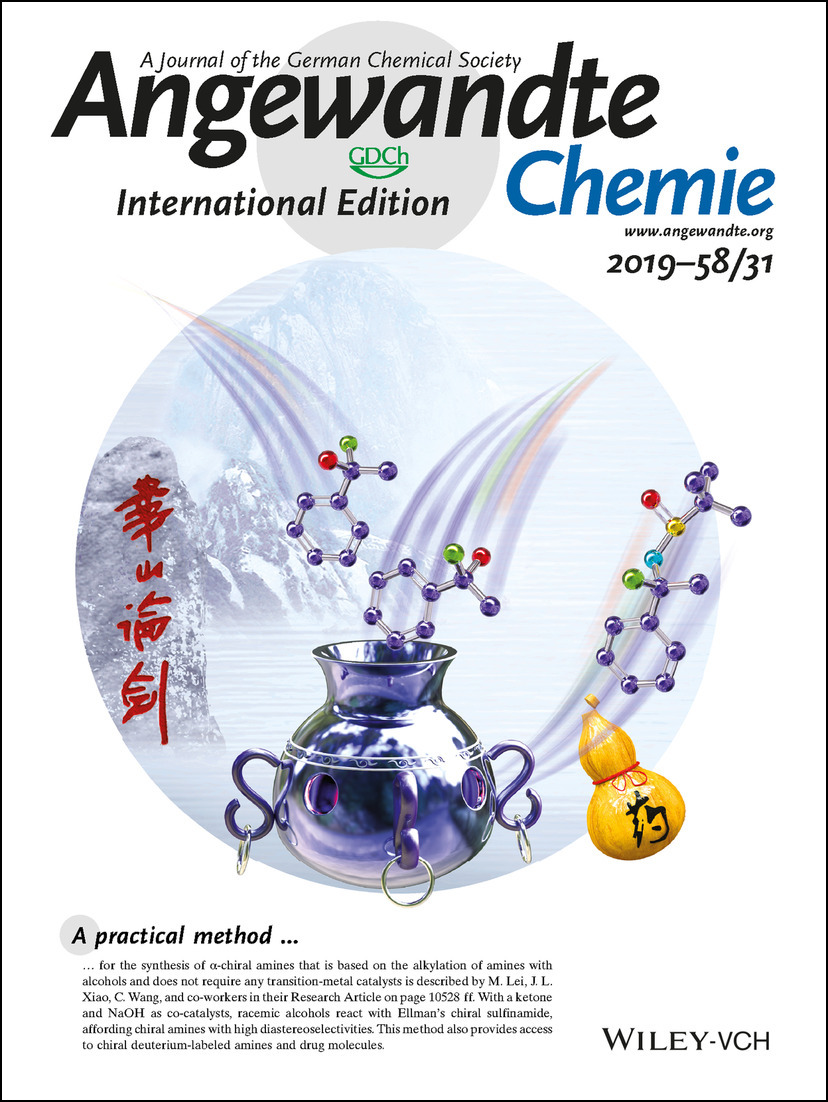
A practical method for the synthesis of α-chiral amines that is based on the alkylation of amines with alcohols and does not require any transition-metal catalysts is described by M. Lei, J. L. Xiao, C. Wang, and co-workers in their Research Article on page 10528 ff. With a ketone and NaOH as co-catalysts, racemic alcohols react with Ellman's chiral sulfinamide, affording chiral amines with high diastereoselectivities. This method also provides access to chiral deuterium-labeled amines and drug molecules.
Frontispiece
Frontispiece: Oxygen Vacancy Diffusion and Condensation in Lithium-Ion Battery Cathode Materials
- First Published: 22 July 2019
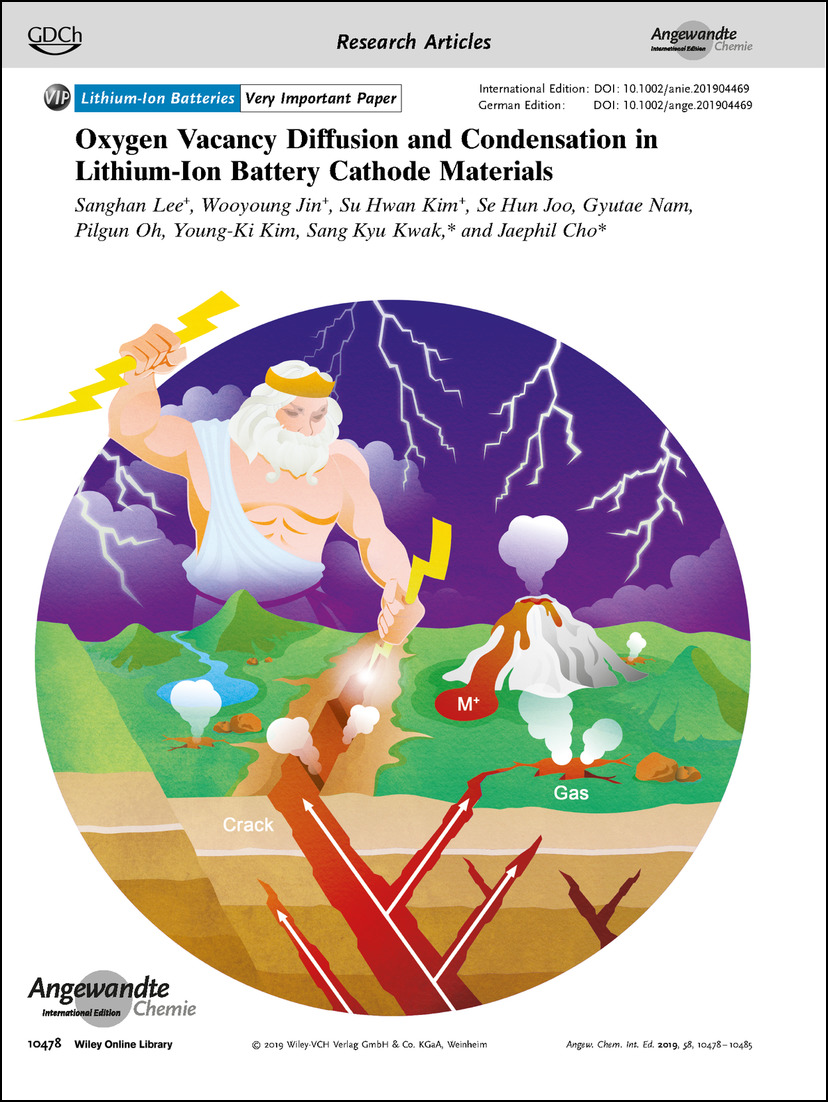
Battery Performance Condensation of oxygen vacancies leads to lattice mismatches and microcracks in transition metal oxides. In their Research Article on page 10478 ff., S. K. Kwak, J. Cho, and co-workers explore this phenomenon in lithium-ion battery cathodes.
Graphical Abstract
Graphical Abstract: Angew. Chem. Int. Ed. 31/2019
- Pages: 10381-10399
- First Published: 22 July 2019
Corrigenda
Corrigendum: Total Synthesis of (−)-Alstofolinine A through a Furan Oxidation/Rearrangement and Indole Nucleophilic Cyclization Cascade
- Page: 10397
- First Published: 22 July 2019
Corrigendum: Fe2Si5N8: Access to Open-Shell Transition-Metal Nitridosilicates
- Page: 10398
- First Published: 22 July 2019
Corrigendum: Core Electron Topologies in Chemical Compounds: Case Study of Carbon versus Silicon
- Page: 10399
- First Published: 10 July 2019
Author Profile
News
Izatt-Christensen Award: L. De Cola / Cram Lehn Pedersen Prize: X. Li / Humboldt Research Award: K. Mashima
- Page: 10403
- First Published: 03 July 2019
Correspondence
Electronic Structure
Correspondence on “Core Electron Topologies in Chemical Compounds: Case Study of Carbon versus Silicon”
- Pages: 10404-10407
- First Published: 09 July 2019
In a recent Communication, Yoshida, Raebiger, Shudo, and Ohno give the impression that so far unreported minuscule changes of the topologies of core orbitals are decisive for the different chemistries of carbon and silicon. However, these conclusions are now shown to be based on computational artifacts and oversimplified models.
Reply to Correspondence on “Core Electron Topologies in Chemical Compounds: Case Study of Carbon versus Silicon”
- Pages: 10408-10409
- First Published: 01 July 2019
In their Correspondence, von Szentpály, Schwarz, Stoll, and Werner claim that the main conclusions of our Communication previously published in this journal are based on computational artifacts and oversimplified models. We clarify the justification of our simple one-electron model to describe one-electron physics, and refute the criticism.
Minireviews
Photopolymerization
Recent Advances and Challenges in the Design of Organic Photoacid and Photobase Generators for Polymerizations
- Pages: 10410-10422
- First Published: 21 December 2018
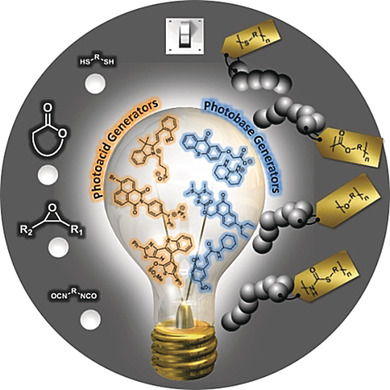
Photopolymerization is a promising method to generate advanced polymers. Particularly significant are photoactive species that form acids or bases upon irradiation by light to initiate polymerization of the monomers. This Minireview highlights the recent advances in the development of organic photobase and photoacid generators.
Nanostructures
Assemblies of Peptides in a Complex Environment and their Applications
- Pages: 10423-10432
- First Published: 22 March 2019
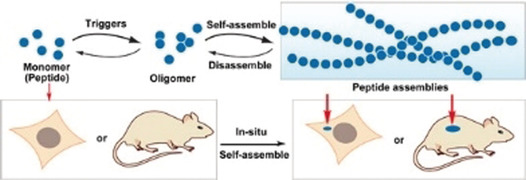
The rational design of peptide assemblies to achieve complex functions in a cellular environment has attracted increasing attention in recent years. In this Minireview, selected examples of peptide assemblies are highlighted, with a focus on instructed assembly for the spatiotemporal control of peptide assemblies in cells.
Reviews
Lithium-Ion Batteries
There and Back Again—The Journey of LiNiO2 as a Cathode Active Material
- Pages: 10434-10458
- First Published: 10 December 2018
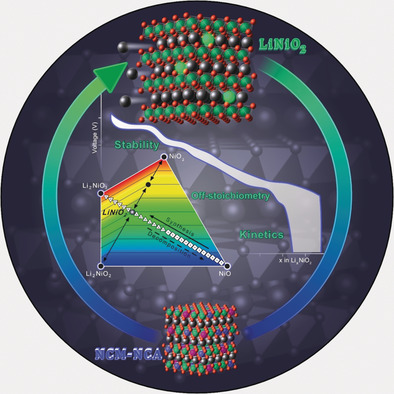
Taking charge: LiNiO2 is one of the most heavily investigated layered oxides for use as the cathode active material of Li-ion batteries. This Review gives a comprehensive overview of this compound, almost 30 years after its introduction. The focus lies in the effect of Li off-stoichiometry, the key instability issues that plague the material and the strategies to overcome them, the open questions, and the most promising future research directions.
Arene Hydrogenation
Selective Arene Hydrogenation for Direct Access to Saturated Carbo- and Heterocycles
- Pages: 10460-10476
- First Published: 30 January 2019
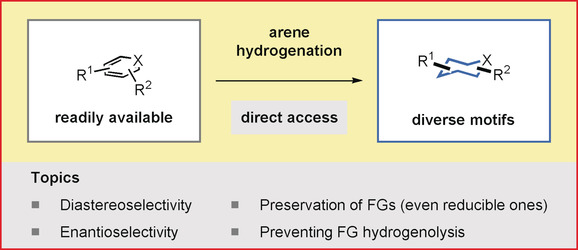
From simplicity, complexity: Modern arene hydrogenation methods provide direct access to complex saturated carbo- and heterocycles by controlling the diastereo-, enantio-, and chemoselectivity. The hydrogenation of multisubstituted arenes generally yields predominantly the cis isomer. Enantiocontrol may be imparted by chiral auxiliaries, Brønsted acids, or transition-metal catalysts. The chemoselectivity can often be controlled by optimization of the catalyst and reaction conditions.
Research Articles
Lithium-Ion Batteries | Very Important Paper
Oxygen Vacancy Diffusion and Condensation in Lithium-Ion Battery Cathode Materials
- Pages: 10478-10485
- First Published: 22 May 2019
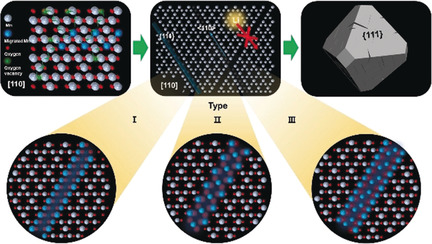
Oxygen vacancies (OV) are native defects in transition metal oxides and their presence has a critical effect on the physicochemical properties of the oxide. Studies reveal that OV diffusion leads to their condensation along a specific lattice plane, resulting in the formation of lattice mismatches and microcracks in single-crystal cathode materials.
Non-Precious Metal Catalysts
Elucidating the Structural Composition of an Fe–N–C Catalyst by Nuclear- and Electron-Resonance Techniques
- Pages: 10486-10492
- First Published: 09 June 2019
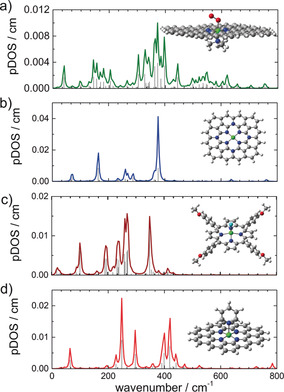
An Fe–N–C catalyst is analyzed using nuclear- and electron-resonance techniques. The results show that even after mild pyrolysis and acid leaching, it contains considerable fractions of α-iron and iron oxide. This raises the question how many FeN4 sites, which are active centers in the oxygen reduction reaction, can be present in Fe–N–C catalysts prepared by pyrolysis at 900 °C and above.
Allylic Compounds
Iridium-Catalyzed Asymmetric Allylic Aromatization Reaction
- Pages: 10493-10499
- First Published: 13 May 2019

An asymmetric allylic aromatization (AAAr) strategy employs readily accessible equivalents of benzylic nucleophiles in iridium-catalyzed allylic substitution reactions with the concomitant formation of aromatic rings. This strategy provides straightforward access to valuable heteroarenes, bearing a homobenzylic stereogenic center, in enantiopure form.
Potassium-Ion Battery | Very Important Paper
Graphite Anode for a Potassium-Ion Battery with Unprecedented Performance
- Pages: 10500-10505
- First Published: 04 June 2019
Sensors | Hot Paper
Dermal Tattoo Biosensors for Colorimetric Metabolite Detection
- Pages: 10506-10513
- First Published: 03 June 2019
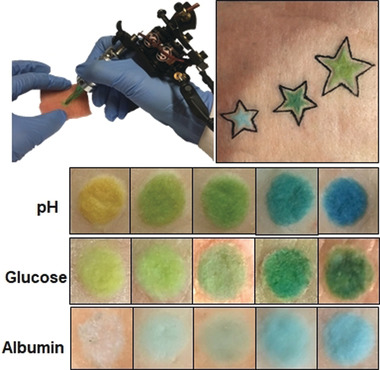
Colorimetric dermal sensors in the form of tattoos have been developed to measure pH, glucose, and albumin concentrations in an ex vivo porcine skin tissue model. The dermal sensors were injected into the dermis in an array format for multiplexed detection. Quantitative readouts were obtained with a smartphone camera.
Photocatalysis
Visible-Light-Photosensitized Aryl and Alkyl Decarboxylative Functionalization Reactions
- Pages: 10514-10520
- First Published: 04 June 2019

Divide et impera: A general strategy to access both aryl and alkyl radicals by photosensitized decarboxylation of the corresponding carboxylic esters is based on an energy-transfer-mediated homolysis of unsymmetric σ-bonds. The independent aryl/alkyl radical generation step enables a series of key C−X and C−C bond-forming reactions by simply changing the radical trapping agent.
Cooperative Catalysis
A Regio- and Stereodivergent Synthesis of Homoallylic Amines by a One-Pot Cooperative-Catalysis-Based Allylic Alkylation/Hofmann Rearrangement Strategy
- Pages: 10521-10527
- First Published: 27 May 2019

Cooperation then amination: A unified one-pot experimental procedure enables a versatile regio- and stereodivergent synthesis of homoallylic amines. Critical to the successful development of this method was the recognition that initial catalyzed C−C bond formation controls all aspects of regio- and stereoselectivity. Thereafter, in situ amination/Hofmann rearrangement results in stereospecific C−N bond formation.
Alkylation | Hot Paper
Transition-Metal-Free Hydrogen Autotransfer: Diastereoselective N-Alkylation of Amines with Racemic Alcohols
- Pages: 10528-10536
- First Published: 04 June 2019

Automatic transmission: An asymmetric hydrogen autotransfer reaction allows the practical synthesis of α-chiral amines by the alkylation of amines with alcohols. Under the co-catalysis of a ketone and NaOH, racemic secondary alcohols react with Ellman's chiral tert-butanesulfinamide, affording chiral amines with high diastereoselectivities (up to >99:1 d.r.). The reaction does not require a transition metal, can be run on a 10 gram scale, and can be used for accessing chiral deuterated compounds.
Communications
Peptide Aggregation
Formation of Neutral Peptide Aggregates as Studied by Mass-Selective IR Action Spectroscopy
- Pages: 10537-10541
- First Published: 24 May 2019
Nanotechnology | Hot Paper
Direct Monitoring of Cell Membrane Vesiculation with 2D AuNP@MnO2 Nanosheet Supraparticles at the Single-Particle Level
- Pages: 10542-10546
- First Published: 21 May 2019
Carbohydrates
Protecting-Group-Controlled Enzymatic Glycosylation of Oligo-N-Acetyllactosamine Derivatives
- Pages: 10547-10552
- First Published: 20 May 2019
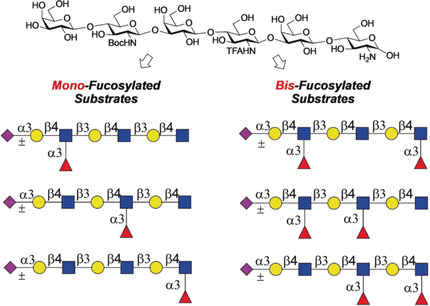
A library of differentially fucosylated and sialylated oligosaccharides was produced starting from a single chemically synthesized tri-N-acetyllactosamine derivative. The resulting oligosaccharides were printed as a microarray that was probed by several glycan-binding proteins, which showed that complex patterns of fucosylation can modulate glycan recognition.
Host–Guest Systems
Targeted Polypeptide–Microtubule Aggregation with Cucurbit[8]uril for Enhanced Cell Apoptosis
- Pages: 10553-10557
- First Published: 04 June 2019
![Targeted Polypeptide–Microtubule Aggregation with Cucurbit[8]uril for Enhanced Cell Apoptosis](/cms/asset/2937cf02-49e6-4406-81d9-5756038ddc59/anie201903243-toc-0001-m.jpg)
Cucurbituril-mediated microtubular aggregation was achieved by modifying an antimitotic peptide with a benzylimidazolium moiety, which could be encapsulated by cucurbituril. The exposed antimitotic peptide could bind microtubules, resulting in aggregation, leading to tumor-cell apoptosis in a mouse model.
Natural Products
The Miharamycins and Amipurimycin: their Structural Revision and the Total Synthesis of the Latter
- Pages: 10558-10562
- First Published: 13 June 2019
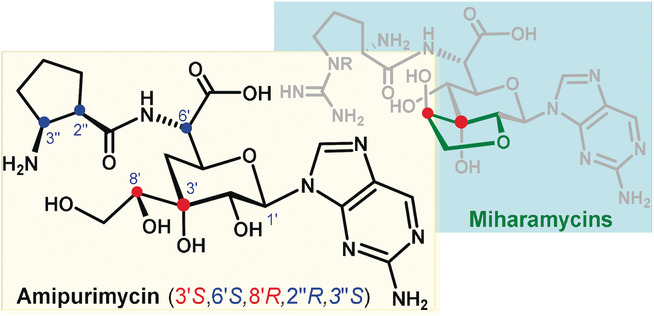
Final piece of the puzzle: The structures of amipurimycin and the miharamycins have been resolved using chemical synthesis and X-ray diffraction analysis. The stereochemistry of amipurimycin has been corrected. The miharamycins have a trans-fused dioxabicyclo[4.3.0]nonane sugar scaffold, which was previously assigned as being in the cis configuration.
Polymers
Propagation and Purification of Human Induced Pluripotent Stem Cells with Selective Homopolymer Release Surfaces
- Pages: 10563-10566
- First Published: 05 June 2019
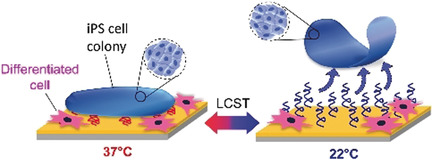
The good ones go into the pot, the bad ones go into your crop: By exploiting the lower critical solution temperature (LCST) behavior of tailored thermoresponsive homopolymer layers, human induced pluripotent stem cells are selectively separated from unintentionally differentiated cells without any releasing reagent.
Photocatalysis
Alternating Copolymers
Linear-Dendritic Alternating Copolymers
- Pages: 10572-10576
- First Published: 29 May 2019
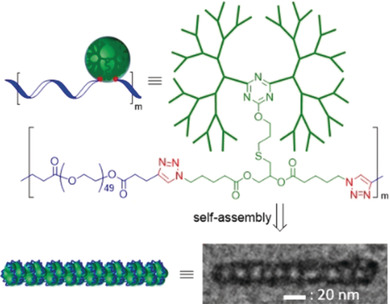
Spaced-out dendrons: Step-growth “click” polymerization using well-defined linear polymeric and dendritic reactants has led to linear-dendritic copolymers in which the linear segments serve as uniform spacers between the dendrons. With alternating hydrophilic linear blocks and hydrophobic dendrons, the copolymers can spontaneously self-assemble into a unique type of microphase-segregated nanorod in water.
Surface Properties
Surface Reconstruction by a Coassembly Approach
- Pages: 10577-10581
- First Published: 24 May 2019

Tuneable surfaces: Surface micelles on silica particles are fabricated by the coassembly of polymer brushes and “free” block copolymer chains in a selective solvent. The surfaces of these modified silica particles present switchable properties upon treatment with water and with tetrahydrofuran (THF).
Nanotechnology
A Safe and Efficient Strategy for the Rapid Elimination of Blood Lead In Vivo Based on a Capture–Fix–Separate Mechanism
- Pages: 10582-10586
- First Published: 21 May 2019
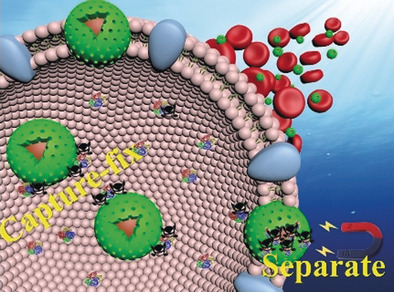
A treatment for lead poisoning, consisting of an Fe3O4 nanoparticle coated with amine-enriched hyperbranched poly(amidoamine)s, and an apparatus enabling the magnetic removal of nanoparticle-associated, lead-containing hemoglobin from the blood have been developed to treat lead poisoning in a safe and efficient way. This strategy enabled the removal of 75% of the lead from pig blood in vivo within 50 minutes.
Ovatodiolide Synthesis
Ovatodiolides: Scalable Protection-Free Syntheses, Configuration Determination, and Biological Evaluation against Hepatic Cancer Stem Cells
- Pages: 10587-10590
- First Published: 29 May 2019
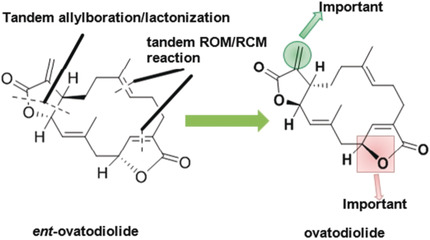
A concise, scalable, and enantioselective synthetic route to ovatodiolides has been devised based on two tandem reactions, including ring-opening metathesis/ring-closing metathesis reactions (ROM/RCM). The butenolide ring and the α-methylene unit were found to be important for the biological activity of these compounds, which inhibit hepatic cancer stem cells and tumorsphere formation.
Battery Electrolytes
A Selection Rule for Hydrofluoroether Electrolyte Cosolvent: Establishing a Linear Free-Energy Relationship in Lithium–Sulfur Batteries
- Pages: 10591-10595
- First Published: 13 May 2019
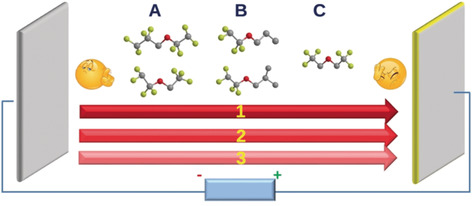
A–B–C easy as 1–2–3: High-performance batteries require tailored electrolyte cosolvents. The lithium-solvating ability of a series of hydrofluoroethers (HFEs), and the linear free-energy relationship between these solvents and lithium polysulfide (LiPS), are reported. HFE structures (A, B, and C) vary with respect to the location of fluoroalkyl groups and an ether oxygen atom. Key: lithium-solvating power (1), conductivity (2), LiPS dissolution (3).
Organocatalysis
Breslow Intermediates from a Thiazolin-2-ylidene and Fluorinated Aldehydes: XRD and Solution-Phase NMR Spectroscopic Characterization
- Pages: 10596-10600
- First Published: 26 May 2019

Back to nature: In vitamin B1-catalyzed umpolung, a Breslow intermediate (BI) is formed from an aromatic thiazolin-2-ylidene and the substrate aldehyde. The combination of a N-Dipp-substituted thiazolin-2-ylidene with pentafluorobenzaldehyde produced a BI, characterized by XRD. When trifluoroacetaldehyde was used, the first BI derived from a thiazolin-2-ylidene and an aliphatic aldehyde was generated, and characterized by NMR spectroscopy.
Molecular Electronics
Multicenter-Bond-Based Quantum Interference in Charge Transport Through Single-Molecule Carborane Junctions
- Pages: 10601-10605
- First Published: 05 June 2019
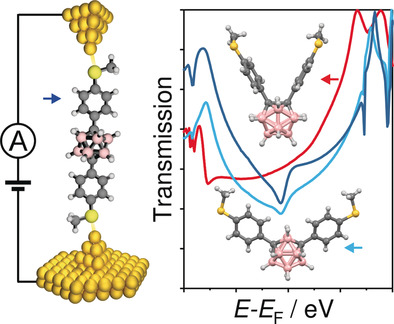
Destructive quantum interference has been demonstrated in charge transport through multicenter-bond-based single-molecule carborane junctions in which all three connectivities of the carborane framework show destructive quantum interference. The transmission channels in meta-connected carborane are comprehensively suppressed by destructive quantum interference, leading to highly insulating molecular junctions.
Drug Delivery | Very Important Paper
Encapsulation of a Phase-Change Material in Nanocapsules with a Well-Defined Hole in the Wall for the Controlled Release of Drugs
- Pages: 10606-10611
- First Published: 04 June 2019

Natural fatty acids were readily loaded into a biocompatible nanocapsule through a well-defined hole in the wall for the controlled release of payloads in response to near-infrared laser irradiation or direct heating. The release profile depends on both the size of the hole and the duration of laser irradiation.
Biosensors | Hot Paper
Molecular Design of a New Diboronic Acid for the Electrohydrodynamic Monitoring of Glucose
- Pages: 10612-10615
- First Published: 05 June 2019
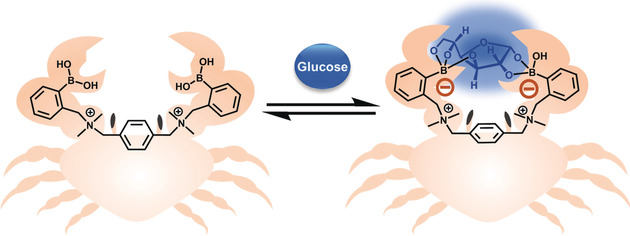
Sugar resistance: A diboronic acid, DBA2+, was prepared, which shows good affinity and selectivity toward glucose and changeable pKa upon binding. DBA2+ was applied to the non-enzymatic, conductimetric monitoring of glucose. With negligible interference from other sugars, DBA2+ shows potential for selective, quantitative, and continuous glucose sensing.
Materials Science
Bacteria-Resistant Single Chain Cyclized/Knotted Polymer Coatings
- Pages: 10616-10620
- First Published: 31 May 2019
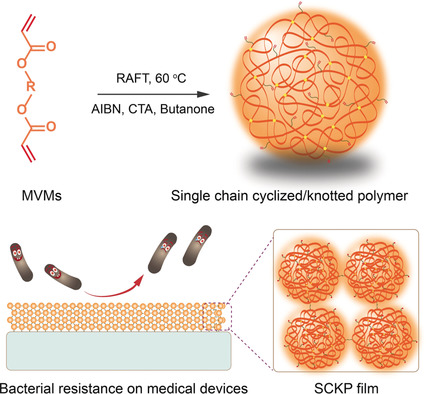
Single chain cyclized/knotted polymer (SCKP) films, synthesized by reversible addition fragmentation chain transfer (RAFT) homopolymerization of multivinyl monomers (MVMs), followed by crosslinking by UV light, exhibit a higher resistance to bacterial attachment and biofilm formation than the corresponding non-SCKP films because of their altered surface morphology. SCKP films could be used to coat medical devices.
Cancer Therapy | Hot Paper
Inhibition of HER2-Positive Breast Cancer Growth by Blocking the HER2 Signaling Pathway with HER2-Glycan-Imprinted Nanoparticles
- Pages: 10621-10625
- First Published: 05 June 2019
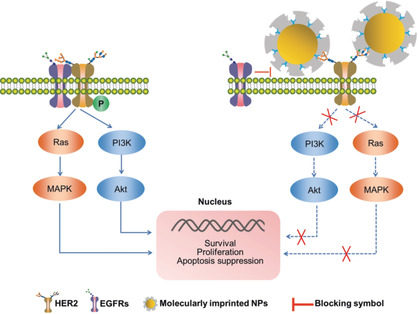
Molecularly imprinted polymers (nanoMIPs) are used to inhibit the growth of HER2-positive breast cancer. NanoMIPs, imprinted using HER2 glycans, can bind to these glycans, preventing HER2 heterodimerization. This blocks HER2-dependent signaling pathways and leads to the inhibition of HER2-positive breast cancer growth.
Nanosheets | Very Important Paper
Construction of a Nanoporous Highly Crystalline Hexagonal Boron Nitride from an Amorphous Precursor for Catalytic Dehydrogenation
- Pages: 10626-10630
- First Published: 03 June 2019
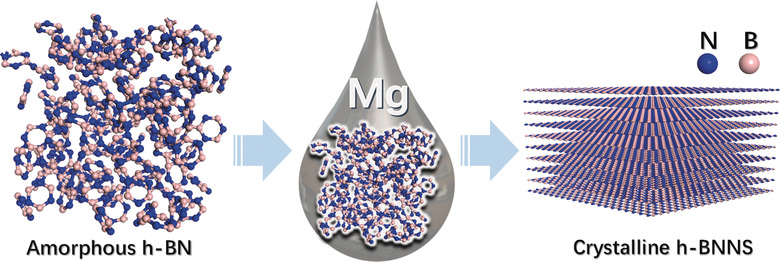
Highly crystalline nanoporous hexagonal boron nitride nanosheets (h-BNNS) were prepared using amorphous h-BN precursors through a dissolution–precipitation/crystallization process in the presence of magnesium. The crystalline h-BNNS is a catalyst for the dehydrogenation of dodecahydro-N-ethylcarbazole.
Antibiotics | Very Important Paper
Diglycine Enables Rapid Intrabacterial Hydrolysis for Activating Anbiotics against Gram-negative Bacteria
- Pages: 10631-10634
- First Published: 05 June 2019
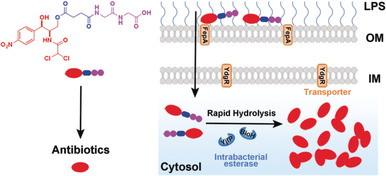
A blessing in disguise: Conjugating a diglycine (GG) to an antibiotic prodrug (chloramphenicol succinate) increases the rate of prodrug activation by increasing the rate of ester-bond hydrolysis catalyzed by bacterial esterases. Dipeptide conjugation to antibiotic prodrugs can increase antibiotic efficacy and reduce adverse drug effects.
Vibrational Coupling | Hot Paper
Cavity Catalysis by Cooperative Vibrational Strong Coupling of Reactant and Solvent Molecules
- Pages: 10635-10638
- First Published: 12 June 2019
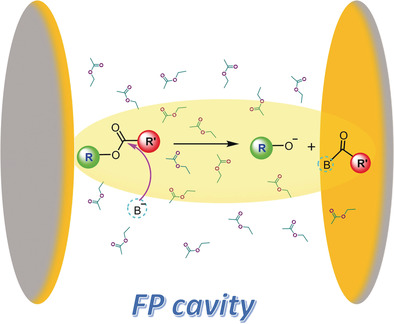
This cavity doesn′t hurt: The solvolysis reaction of para-nitrophenyl acetate is accelerated by an order of magnitude through cooperative vibrational strong coupling of the reactant and solvent molecules at room temperature. The reaction mixture is injected into a Fabry–Perot (FP) cavity and the cavity mode is tuned to the carbonyl stretching mode of both the reactant and solvent molecules together to achieve strong coupling.
Bioinorganic Chemistry
Hydrogen by Deuterium Substitution in an Aldehyde Tunes the Regioselectivity by a Nonheme Manganese(III)–Peroxo Complex
- Pages: 10639-10643
- First Published: 20 May 2019
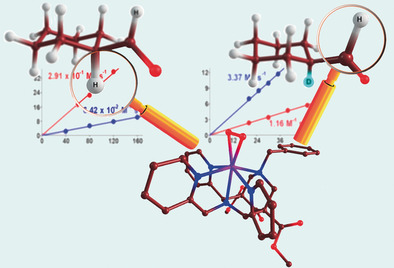
Regioselective hydrogen-atom abstraction: A combined experimental and computational study gives evidence of electrophilic reactivity of a side-on manganese(III)–peroxo complex. Furthermore, isotopic substitution of the substrate changes the regioselectivity of the reaction and the product distributions.
Metal–Organic Frameworks
Enhanced Electrocatalytic Hydrogen Oxidation on Ni/NiO/C Derived from a Nickel-Based Metal–Organic Framework
- Pages: 10644-10649
- First Published: 02 June 2019
Polycyclic Aromatic Hydrocarbons
Functionalized Contorted Polycyclic Aromatic Hydrocarbons by a One-Step Cyclopentannulation and Regioselective Triflyloxylation
- Pages: 10650-10654
- First Published: 24 May 2019
Host–Guest Chemistry
Guest Binding via N−H⋅⋅⋅π Bonding and Kinetic Entrapment by an Inorganic Macrocycle
- Pages: 10655-10659
- First Published: 03 June 2019
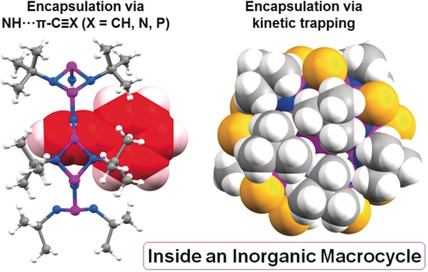
Ringing the Changes: The inorganic phosph(III)azane [{P(μ-NtBu)}2NH]5 macrocycle provides a unique H-bonding host environment for N−H⋅⋅⋅π bonding to alkynes, nitriles, and the PCO− anion. Oxidation of the PIII periphery with sulfur kinetically entraps halide ion guests, which cannot be abstracted even with powerful methylating agents.
Photodynamic Therapy
Luminescent, Oxygen-Supplying, Hemoglobin-Linked Conjugated Polymer Nanoparticles for Photodynamic Therapy
- Pages: 10660-10665
- First Published: 07 June 2019
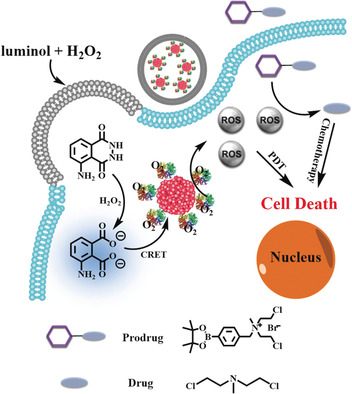
A photodynamic therapy system has been developed using hemoglobin-linked conjugated polymer nanoparticles that can luminesce and supply oxygen. This system does not require an external light source and circumvents the problem of low molecular oxygen levels found in hypoxic tissue. This system could also be used for the controlled release of an anticancer prodrug, combining PDT and chemotherapy.
Photocatalytic H2 Evolution | Hot Paper
Core–Shell-Structured LaTaON2 Transformed from LaKNaTaO5 Plates for Enhanced Photocatalytic H2 Evolution
- Pages: 10666-10670
- First Published: 16 May 2019
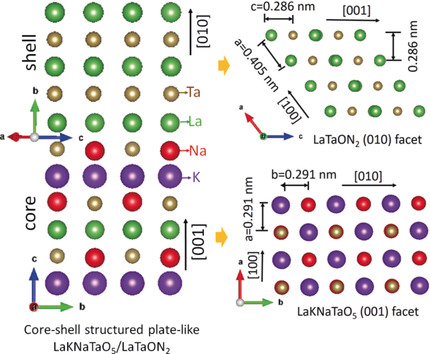
Core–shell structured plate-like LaKNaTaO5/LaTaON2 containing LaTaON2 shells exposing (010) facets and having a low defect density on the lattice-matched LaKNaTaO5 cores was obtained by a brief nitridation process. When modified with a Rh co-catalyst, LaKNaTaO5/LaTaON2 exhibited photocatalytic H2 evolution activity four times greater than that obtained from conventional LaTaON2 powders with uncontrolled facets.
Direct Methane Conversion
Efficient and Selective Methane Borylation Through Pore Size Tuning of Hybrid Porous Organic-Polymer-Based Iridium Catalysts
- Pages: 10671-10676
- First Published: 29 May 2019
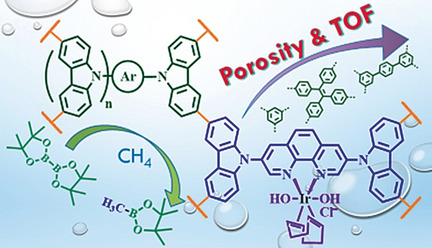
Pore patrol: A series of heterogenous catalysts based on iridium complexes bound inside porous polycarbazoles was prepared for the selective monoborylation of methane. Catalysts with high efficiency and good chemoselectivity can be developed through tuning the pore size distribution of the porous polycarbazole.
ORR Catalysts
A Phthalocyanine-Based Layered Two-Dimensional Conjugated Metal–Organic Framework as a Highly Efficient Electrocatalyst for the Oxygen Reduction Reaction
- Pages: 10677-10682
- First Published: 06 June 2019
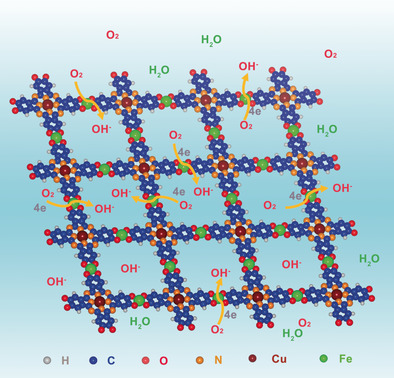
Thanks to the links: A copper phthalocyanine-based 2D conjugated MOF with square-planar cobalt bis(dihydroxy) units (Co-O4) as linkages serves as an electrocatalyst for the oxygen reduction reaction with high catalytic activity (E1/2=0.83 V vs. RHE). The linking Co centers with optimized electronic structure (eg=1) are identified as the active sites.
Diyne Carbonylation
Stereoselective Synthesis of Highly Substituted Conjugated Dienes via Pd-Catalyzed Carbonylation of 1,3-Diynes
- Pages: 10683-10687
- First Published: 24 May 2019
Fluoroolefins
C−H and C−F Bond Activation Reactions of Fluorinated Propenes at Rhodium: Distinctive Reactivity of the Refrigerant HFO-1234yf
- Pages: 10688-10692
- First Published: 18 May 2019
C−C Cleavage | Hot Paper
Practical Catalytic Cleavage of C(sp3)−C(sp3) Bonds in Amines
- Pages: 10693-10697
- First Published: 24 May 2019
Organocatalysis
Phosphine-Catalyzed Activation of Alkylidenecyclopropanes: Rearrangement to Form Polysubstituted Furans and Dienones
- Pages: 10698-10702
- First Published: 15 May 2019
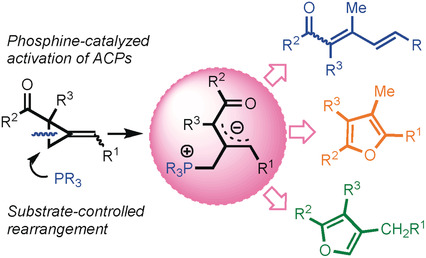
One to three: Phosphine-catalyzed activation of alkylidenecyclopropanes (ACPs) generates allylic phosphonium intermediates that resemble the well-studied phosphine-allene adducts but exhibit distinct properties. These intermediates facilitate three types of rearrangements to form polysubstituted furans and dienones.
Reaction Mechanisms
Propargylsilanes as Reagents for Synergistic Gold(I)-Catalyzed Propargylation of Carbonyl Compounds: Isolation and Characterization of σ-Gold(I) Allenyl Intermediates
- Pages: 10703-10707
- First Published: 20 May 2019

Golden capture: A σ-gold allenyl intermediate was isolated and characterized during the study of a novel gold-catalyzed propargylation reaction. Propargylsilanes serve as very effective reagents for the propargylation reaction of carbonyl compounds. The reaction can be directed toward formation of either homopropargyl silyl ethers or the in situ synthesis of 2-silyl-4,5-dihydrofurans. TBS=tert-butyldimethylsilyl, TMS=trimethylsilyl.
Boron–Nitrogen Heterocycles
BN-Embedded Tetrabenzopentacene: A Pentacene Derivative with Improved Stability
- Pages: 10708-10712
- First Published: 24 May 2019
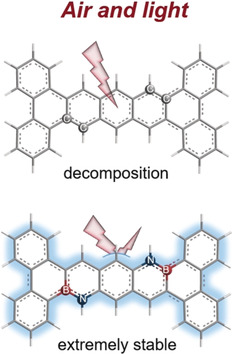
Make stable: BN-embedment is demonstrated to play an important role in stabilizing a pentacene derivative by tuning the orbital distribution and lowering the HOMO energy level. This study provides an effective strategy to attain stable acenes without changing the molecular configuration or intermolecular packing structure, and thus improves the potential application of large acenes in electronic devices.
Hydrogen Evolution Reaction
Boosting Electrocatalytic Hydrogen Evolution over Metal–Organic Frameworks by Plasmon-Induced Hot-Electron Injection
- Pages: 10713-10717
- First Published: 03 June 2019
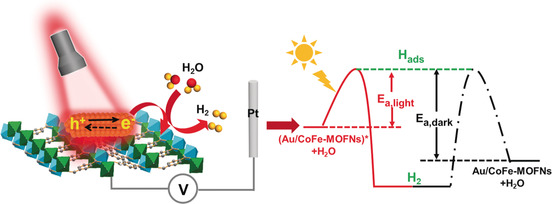
Some like it hot: A composite of Au nanorods/CoFe-MOF nanosheets (Au/CoFe-MOFNs) was used as an electrocatalyst for the hydrogen evolution reaction (HER). Au/CoFe-MOFNs give a four-fold increase of current density and a much reduced activation energy upon light irradiation as a result of hot-electron injection from plasmonic Au to CoFe-MOFNs.
C−C Coupling
Total Synthesis of Clavosolide A via Asymmetric Alcohol-Mediated Carbonyl Allylation: Beyond Protecting Groups or Chiral Auxiliaries in Polyketide Construction
- Pages: 10718-10722
- First Published: 05 June 2019
Conjugate Addition | Hot Paper
Copper-Catalyzed Regio- and Enantioselective Addition of Silicon Grignard Reagents to Alkenes Activated by Azaaryl Groups
- Pages: 10723-10726
- First Published: 29 May 2019

New kid on the block: Silicon Grignard reagents can be used in a new enantioselective copper-catalyzed reaction. With the assistance of BF3⋅OEt2, a CuI-josiphos complex promotes the highly regioselective addition of silicon Grignard reagents to alkenyl-substituted heteroarenes (see scheme). The new method expands the scope of “conjugate addition” type reactions forming C(sp3)−Si bonds.
Nucleophilic Substitution
Latent Nucleophiles in Lewis Base Catalyzed Enantioselective N-Allylations of N-Heterocycles
- Pages: 10727-10731
- First Published: 07 May 2019
CO Methanation
Morphology-Engineered Highly Active and Stable Ru/TiO2 Catalysts for Selective CO Methanation
- Pages: 10732-10736
- First Published: 16 May 2019
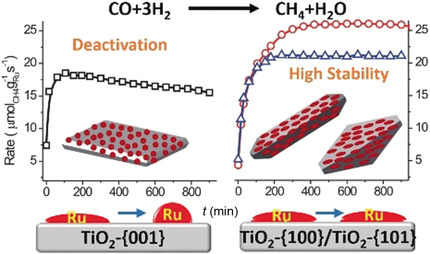
Keeping it flat: Morphology-engineered TiO2-{100} and TiO2-{101} nanocrystal supports can stabilize flat Ru nanoparticles, resulting in a very stable activity of the Ru/TiO2 catalysts for the selective CO methanation. Weaker metal–support interactions on the TiO2-{001} nanocrystals result in a shape change of the Ru nanoparticles, from flat to hemispherical, together with continuous deactivation.
Ring-Opening Polymerization
Lewis Pair Polymerization of Epoxides via Zwitterionic Species as a Route to High-Molar-Mass Polyethers
- Pages: 10737-10741
- First Published: 17 May 2019
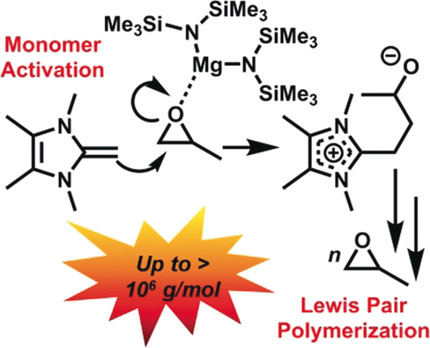
So long! Poly(propylene oxide) with exceptionally high molar mass can be prepared with a catalytic setup consisting of a nucleophilic N-heterocyclic olefin and a magnesium-based Lewis acid. The magnesium species activates the monomer for attack by the olefin, resulting in a rapid, Lewis pair type polymerization via zwitterionic species.
Photochemistry
Covalency-Driven Preservation of Local Charge Densities in a Metal-to-Ligand Charge-Transfer Excited Iron Photosensitizer
- Pages: 10742-10746
- First Published: 30 May 2019
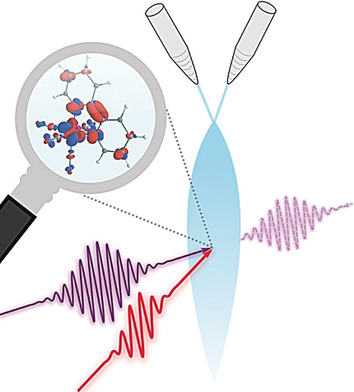
Covalent effects compensate for photo-induced charge variations within a charge-transfer excited transition-metal dye. Using time-resolved X-ray absorption spectroscopy and DFT calculations, the underlying mechanism is found to uphold local charge densities at the photo-oxidized transition-metal center, while transferring spin density to peripheral parts of the molecule.
Precision Polymers
Learning from Peptides to Access Functional Precision Polymer Sequences
- Pages: 10747-10751
- First Published: 25 April 2019

Not lost in translation: A new strategy to guide sequence design for accessing functional precision polymers is described. The direct translation of side-chain functionality sequences into nonpeptidic backbones leads to macromolecules that mimic or improve on the properties of the parent peptide. As an example, the approach was applied to a peptide-based formulation additive to solubilize a photosensitizer drug.
Clickmers
A Receptor-Guided Design Strategy for Ligand Identification
- Pages: 10752-10755
- First Published: 03 May 2019
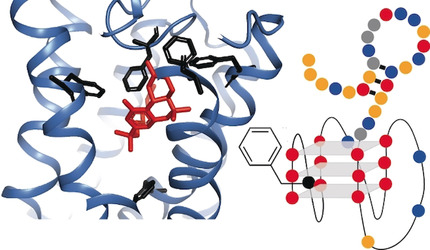
Oligo(deoxy)nucleotide ligands are effective tools for the manipulation, detection, and study of biological phenomena. A receptor-guided design strategy based on the hydrophobic molecule (−)-Δ9-tetrahydrocannabinol (THC) was used to generate a modified DNA library capable of identifying clickmers (modified aptamers).
Vitamin B12 | Very Important Paper
The Hydrogenobyric Acid Structure Reveals the Corrin Ligand as an Entatic State Module Empowering B12 Cofactors for Catalysis
- Pages: 10756-10760
- First Published: 22 May 2019
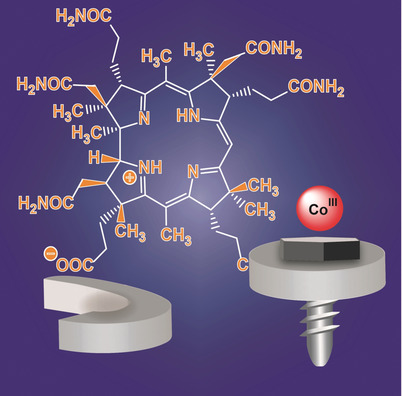
Hydrogenobyric acid, the metal-free corrin ligand of the natural B12 derivatives, has been prepared via an engineered biosynthesis. Its structure revealed a uniquely ring-contracted and strongly helical ligand cavity. It binds cobalt ions tightly in an entatic state strained by coordinative misfit. This activates the B12 cofactors for homolytic and reductive cleavage of their organometallic Co−C bond, which is key for catalysis by B12-dependent enzyme reactions.




